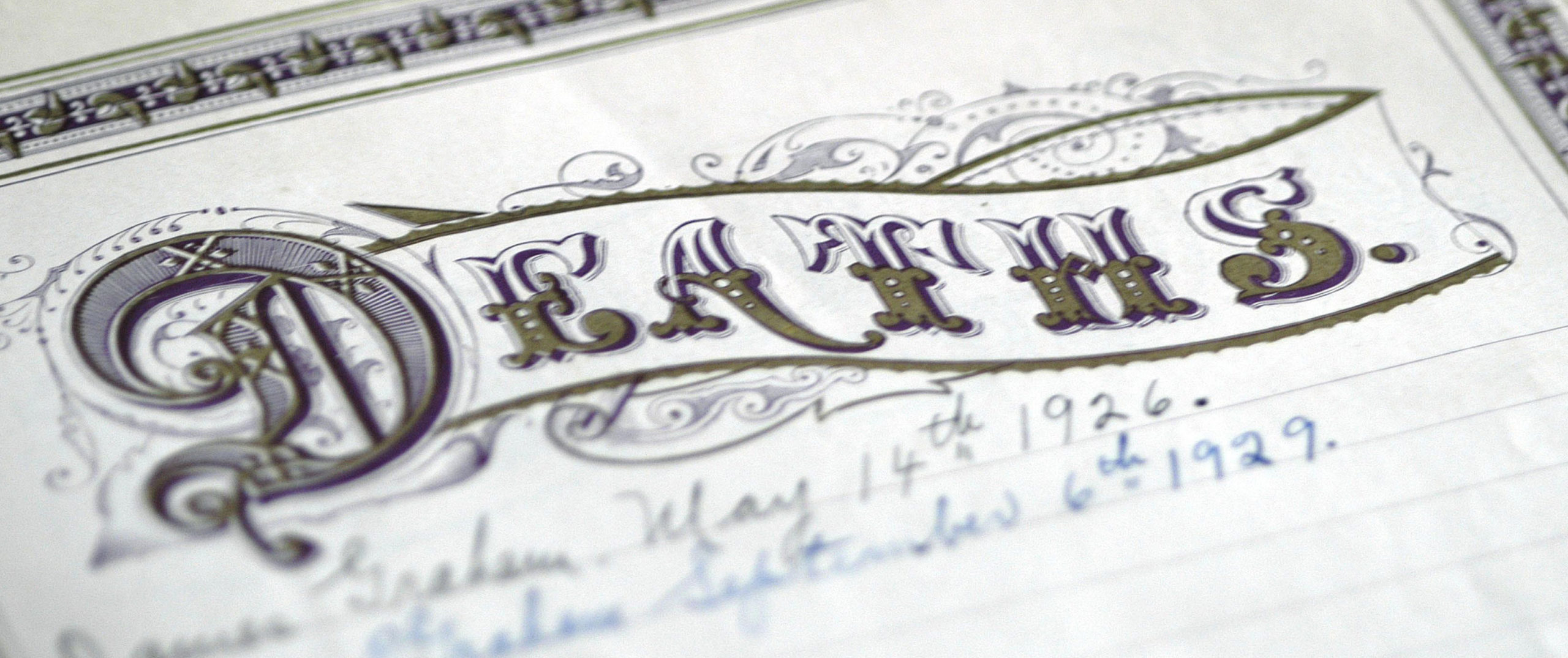
Death Records: A Checklist of Ten Documents Every Genealogist Should Own, By William Dollarhide
This blog is an adaptation of an article by William Dollarhide that appeared in a Genealogical Pointers in December 2006.
Here are ten places to look for a death record. All ten sources should be obtained for every ancestor on your pedigree chart and every member of a family on your family group sheet.
1. DEATH CERTIFICATES. Always start with a death certificate as the names, dates, and places it contains will lead you to even further records. (Please remember that the certificate in itself is the beginning, not the end, of your search and that the information included may be incorrect.) A good rule is to treat the brothers and sisters of your ancestor as equals. Obtain a death certificate for each deceased ancestor on your pedigree chart, and for every deceased brother or sister of that ancestor. For example, if there were six siblings in the family, a death certificate for each sibling will give six different sources about the same parents, places where the family lived, names of spouses, names of cemeteries, names of funeral directors, and other facts about a family. If a death certificate for your ancestor fails to provide the name of the deceased’s mother, a sibling’s death certificate might give the full maiden name. How do you get a death certificate? Go to the www.vitalrec.com where detailed information about accessing death records can be found. It is a free-access website and all fifty states, the District of Columbia, and all U.S. territories or possessions are represented.
2. FUNERAL RECORDS. A death certificate may mention the name and location of a funeral director. Find a current funeral home in North America at www.funeralnet.com. This site has the listings from a directory of funeral homes called “The Yellow Book.” A funeral record may include names of survivors, names of the persons responsible for the funeral expenses, and, often, obscure biographical information about the deceased not available anywhere else. Modern funeral records are full of genealogical information about the deceased and may include copies of newspaper obituaries, death certificates, printed eulogies, funeral programs, and other details about the person. A reference to a burial permit, cremation, or cemetery can be found here as well. Generally, funeral directors are very easy to talk to and very cooperative. Even if the old name of a funeral home is not listed in a current directory, it should be possible to locate the current funeral home holding the records of an earlier one. Funeral homes rarely go out of business but, more often, are taken over by another funeral director. If at one time a town had two or three funeral homes, but only one today, the “Yellow Book” listing is still the source for finding the current funeral home in that town because it can lead you to information about the older funeral home. Funeral directors are also experts on the location of cemeteries in their area.
3. CEMETERY RECORDS. If the name of a cemetery is mentioned on the death certificate or funeral record, there may be a record in the sexton’s office of the cemetery or off-site at a caretaker’s home; the gravestone inscription may be revealing as well. When you contact a funeral home, ask about the cemetery where the person was buried and whether the funeral home has an address or phone number for the cemetery office, or if it can give you the name of the keeper of the cemetery’s records. Ask the funeral director for the names of monument sellers who cater to cemeteries in the area. A local stone mason may have a record of a monument inscription for the deceased’s gravestone. To locate a cemetery anywhere in the U.S., a special list can be obtained from the United States Geological Survey’s (USGS) Geographic Names Information System (GNIS). The GNIS contains the names of over two million place names (map features) in America, of which about 107,000 are cemeteries. The GNIS website is located at http://geonames.usgs.gov/. Click on “Domestic Names” to search for any named cemetery.
4. OBITUARIES. A newspaper obituary was probably published soon after the person’s death. Old newspapers from the town where the person died are usually available in the local public library. They might be on microfilm. Find the website for any library in the U.S. at the Libweb-Library Servers site at http://www.lib-web.org/.
If the library responds but says it is unable to look for an obituary or make copies for you, then you might need to find a person living in that town to go to the library for you. One way to locate such a person is to write to a local genealogical society and ask if they know someone who can do a bit of research for you. Most genealogical societies have a volunteer who responds to such requests, and there will most likely be a small fee for this service. A good list of American genealogical societies is in The Genealogist’s Address Book, 6th Edition, edited by Elizabeth Petty Bentley (Baltimore: Genealogical Publishing Co., 2005; see the following article for more information about this resource.) You might also find a genealogy helper on the Internet. Do a place search for people involved in genealogy in a locale near where you need help, drop them an e-mail message, and promise to do something for them in exchange. Some historic newspaper obituaries are beginning to appear on the Internet. Check www.cyndislist.com under the category “obituaries” for direct links to websites on the Internet specific to actual obituaries transcribed and made available in various sites. Also, use your browser to search for “obituaries,” which should provide names of newspapers, dates, etc., and what might be available.
5. SOCIAL SECURITY RECORDS. If a person died within the last 35 years or so, the death certificate probably includes the deceased’s Social Security number. With or without a person’s Social Security number, you can write for a copy of any deceased person’s original application for a Social Security card, called a form SS-5. Since 1935, virtually every working person in America has applied for a Social Security account. You will need to consult the Social Security Death Index (SSDI) to see if the person is listed. Most people who died after 1962 will be listed there. One of the easiest of these look-up services is found at https://go.fold3.com/ssdi, where you can search in the SSDI by the surname, or optional first name, or the place in the U.S. where a person died. With the name and Social Security number, you can obtain a copy of the deceased’s application for a Social Security account. This document was completed by the person and gives his/her full name, date and place of birth, place of residence, names of parents, occupations, and names of employers. For deaths before 1962, the RootsWeb SSDI site is still a good place to start; click on any person to get the form letter asking for a form SS-5, modify it to fit the person you want, and add more details.
6. PROBATE RECORDS. Details pertaining to a deceased person’s estate may be located in a county courthouse. These records may provide important information about the heirs of the deceased. Probate records may include dockets (court calendars), recorded wills, administrator’s records, inventories of estates, sheriff’s sales, and judgments. Microfilmed probate records for nearly every county in the U.S. are located at the Family History Library in Salt Lake City. To find them, go to www.familysearch.org . Do a “place” search for a state, then click on “Review Related Places” to see a list of the counties for that state. The topics listed include probate records, so a review of what records have been filmed can be located quickly.
7. PRIVATE DEATH RECORDS (Insurance Papers, Medical Records, Doctor’s Office Records). If the deceased had insurance, there will be a record of the death within the insurance company’s files, perhaps with information concerning the deceased’s survivors and the disposition of an estate. Hospital records are almost always closed, but a close family member might be able to obtain information. Records at a doctor’s office are usually closed also, but, again, close family members might be given access.
8. CORONER AND MEDICAL EXAMINER RECORDS exist for any person who died under suspicious conditions, any person for whom an autopsy was performed, or, in most cases, for people who died outside of a hospital. Coroner records are public records kept at the county level in virtually all states. In addition to the circumstances of the death, there may be vital details about the deceased. Locating a coroner or medical examiner for a county is not difficult as many have their own websites or are part of a county government website.
9. MEDICAL RECORDS for deceased veterans are public records. The National Archives and Records Administration, National Personnel Records Center (Military Records Facility) is located at 9700 Page Ave., St. Louis, MO 63132-5100. Write for a form SF-80 to request copies from any soldier’s or sailor’s military file. Their online website is www.archives.gov/st-louis/military-personnel/index.html. Next-of-kin to a deceased veteran may access data online. Others must use form SF-80 to obtain information about the deceased veteran.
10. CHURCH RECORDS. A death record might be recorded as part of a church’s records in addition to information about a burial. Check www.cyndislist.com under the category “Religion and Church” to survey what is available online.
GO GET THE DEATH RECORDS!
A death certificate is not enough, and it might not even be correct. If you know a person’s exact date and place of death, then you have several more sources pertaining to a person’s death. If you can obtain these other death records, you will certainly learn more about your ancestors.
Tools for Locating Death Records
Speaking of death records, each of the following research aids would be an asset for anyone hunting for death records.
Genealogy at a Glance: American Cemetery Records
Cemeteries are not just hallowed and mysterious places, they are also repositories of genealogical knowledge, their tombstones providing crucial information ranging from the name of the deceased and his birth and death dates to a bonanza of biographical detail that often includes the names of parents, children, and spouse. But tombstones are more like artifacts than documents, and they require a different approach and give rise to different expectations. In its now familiar format, this “Genealogy at a Glance” publication addresses these grave issues, expertly covering the unique aspects of cemetery research in four specially laminated pages. View Book Details
County Courthouse Book. New 3rd Edition
This directory includes the names, addresses, phone numbers, and dates of organization of all county courthouses. For most courthouses, it gives a concise summary of record holdings (e.g., burial records), personnel, and services. View Book Details
Genealogy At a Glance: Court Record Research
You could make a lifetime’s study of the American court system, but if your goal is family history research, this Genealogy at a Glance outline will provide an indispensable shortcut, guiding you through the major types of court records that are crucial in your research—probate records, for example, naturalization records, land records, marriage and divorce records, tax records—in short almost every type of record that helps to identify family relationships. The main thing you will learn is that county courthouses generally contain the records of most interest to genealogists, and therefore this guide offers invaluable tips for finding and accessing records at the county courthouse level. View Book Details
International Vital Records Handbook. 6th Edition
Divided into two parts, this sixth edition contains the latest forms and ordering information for birth, marriage, death, and divorce records for each of the 50 states and also furnishes details about the records that were created prior to statewide vital records registration. Then, in alphabetical sequence, it covers all the other countries of the world, giving, where available, their current forms and instructions. Since many nations have neither a centralized vital records registration system nor application forms of any kind, this work provides as a substitute a list of national and provincial record repositories or key addresses of other institutions that might be of assistance. View Book Details
The Researcher’s Guide to American Genealogy to American Genealogy. 3rd Edition
Among other things, The Researcher’s Guide contains an in-depth discussion of death and other vital records in the U.S., including where and how to find them. This fourth edition incorporates the latest thinking on genealogy and computers, specifically the relationship between computer technology (the Internet and CD-ROM) and the timeless principles of good genealogical research. It also considerable discussion of the use of DNA for genealogical purposes. View Book Details


